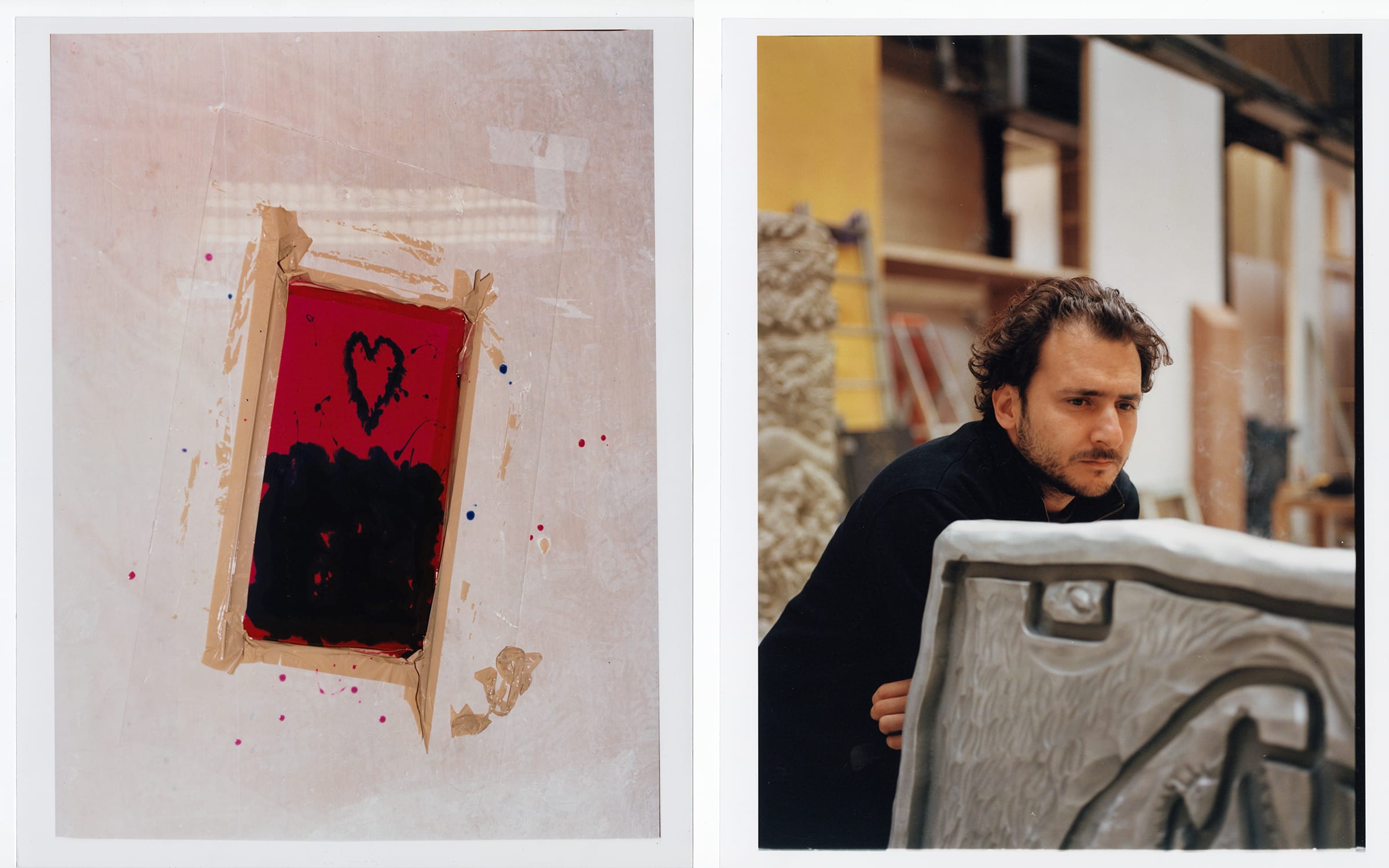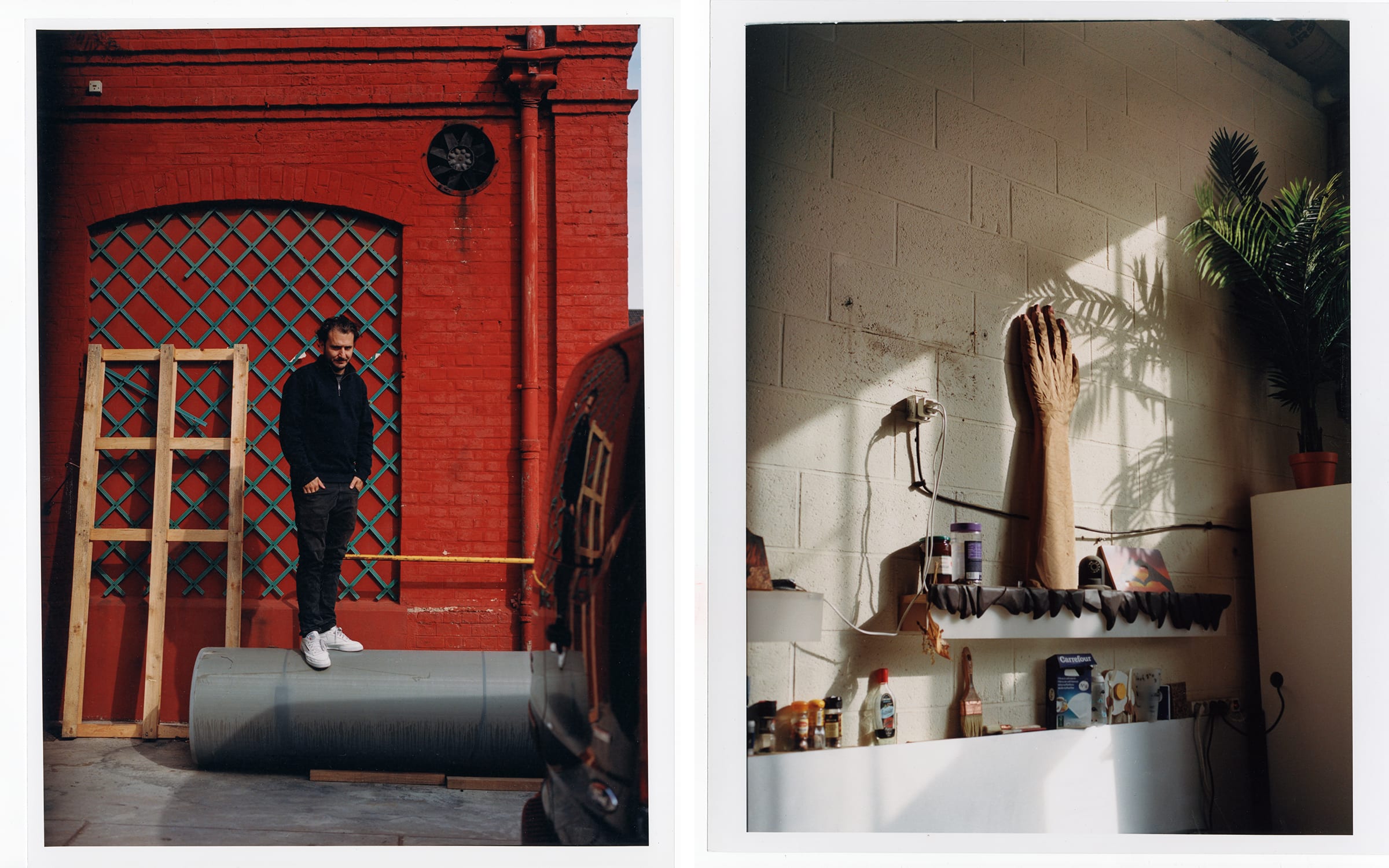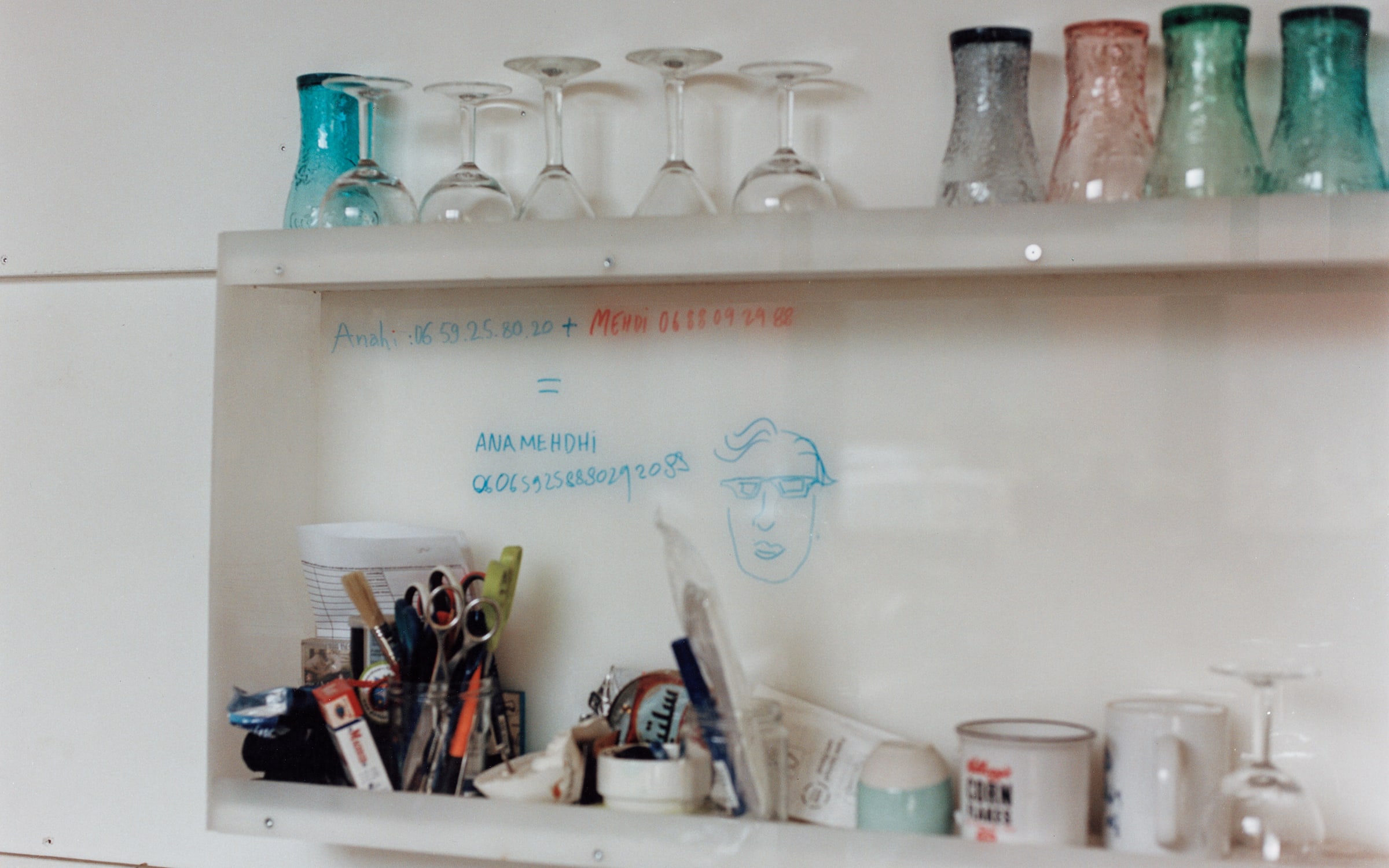At the Venice Biennale, Neïl Beloufa made a splash with his troubling interviews of soldiers. For Miami Beach, he’ll turn his attention to children’s storytelling
A camel, a fox, and a little girl act out a secret narrative on the French artist’s latest series of reliefs
Log in and subscribe to receive Art Basel Stories directly in your inbox.
Neïl Beloufa’s studio is in an old industrial complex once used by silversmith Christofle in Saint-Denis, a northern suburb of Paris. On a gray, rainy day as I wander the alleyways connecting the buildings that were once a factory and showroom for expensive silverware, I pass by a film crew shooting a daytime scene with huge lights. This is pure coincidence, but walking through this artificial sun feels like an introduction to Beloufa’s work, where things are never quite what they seem.
Beloufa’s first major work, Kempinski (2007), is a video shot in Mali when the French-Algerian artist was just 22. The camera pans across streets, lamps, and the fronts of houses at nighttime. Like in a documentary, people speak directly to the camera, only Kempinski is science fiction: the Malians interviewed don’t share their daily experience, but instead discuss their ideas of the future in present tense, using the first person plural. ‘We don’t need cars; we move through light, through sound,’ says a young man. In this brave new world, sex is telepathic and ‘all goes quickly – it is like a light speed,’ he adds. ‘We have space stations,’ says another man, while a youngster carrying a lamp explains that new tools are all in the mind: ‘Once you think about something, you have it in front of you.’ In a 2015 interview with Even magazine, Beloufa said Kempinski was a ‘fuck-you to the West,’ in which the Malians basically say: ‘We live in the future, you don’t.’

Interviews, coupled with a faux-documentary approach, have reappeared in Beloufa’s work ever since Kempinski. In the intervening years, the artist’s videos and sculptural installations have been presented at numerous major institutions, including the ICA in London and MoMA in New York. Beloufa also participated in the Venice Biennale twice, in 2013 and in the recent edition, where he showed Global Agreement (2018-19), a series of videos capturing soldiers sharing their experiences of military life from Syria to Ghana. To watch Global Agreement, viewers had to adjust their bodies to fit into the gym equipment-like devices in which the screens were embedded and view the one-on-one interviews.
Beloufa met all the soldiers featured via social networks. Speaking over Skype, he asked them to talk about their personal experiences and memories, and to share their thoughts on the nations that had sent them to war. When he tried to figure out how to sort the videos and arrange them in space, he said he was looking for a way of classification that wasn’t making any universalist or moralistic claims. ‘An identity politics-based model – focusing on gender or race – would fail, as would an ideological model,’ Beloufa explains, ‘because being a woman in the Israeli army has nothing to do with being a woman in the Ghanaian army; likewise being a liberal in the US isn't the same as being a liberal in Iran. Most taxonomies would have been crooked with judgment.’ His solution? Arranging the videos according to the types of internet connection the soldiers used for their interviews. This seemingly minor detail was often very revealing. ‘If they used a VPN, they’re in a state which controls citizens’ communication,’ Beloufa continues. ‘A personal laptop means they are young, often North American. Older soldiers often used someone else’s device because they didn’t have smartphones. An EDGE connection [mobile data pre-3G] mostly meant I was speaking with someone from a remote area in a country with low GDP. You can map the entire world by access.’
Beloufa continues talking about technology and access as key concerns for the new works his Los Angeles gallerist, François Ghebaly, will be presenting in the Nova sector of Art Basel Miami Beach. ‘Access shows social class on a global system,’ Beloufa explains. He grabs my phone, which is on the kitchen counter between us, recording our conversation, and pretends to look at it closely. Soon, he says, ‘the higher classes will have direct access to nature; while the lower classes will see the countryside in 3D on their phones.’ Not that the 3D experience is in any way less real – he points to my phone again and says: ‘as far as our society is concerned this is reality, more than that’ (his hand gestures towards the outside world).
When Beloufa describes the pieces he’ll be showing at Miami Beach, he calls them ‘screens’. Sometimes, he refers to them as ‘objects’. He never calls them ‘paintings’ even though it’s what they look like the most. Collectively titled ‘The Moral of the Story’, these make up a series of 2D objects hanging on the walls, accompanied by projections (‘And maybe a bench! If I have the time,’ says Beloufa, whose exhibitions often involve semi-architectural elements). The works are 2D objects made of acrylic resin and painted in acrylic which appear as reliefs of abstract lines in pastel colors when illuminated. They ‘look like toys,’ says Beloufa. However, when exhibited in a show or at an art fair, these pieces become supports for projected images (often taken by the artist on his phone) that form a children’s story Beloufa wrote for the exhibition.

The projected images tell the bizarre tale of a camel who once carried tourists in the city but gets too old to keep doing his job and is sent back to the desert. There, he meets a little fennec (a kind of wild fox that is also the symbol of Algeria, where Beloufa’s family is from) girl who invites him home with her. She lies in his shade to hide from the sun, then tells other people from the village to do the same. The commodity – the shade from the camel’s humps – becomes rarified, and an economy develops around it. The piece finishes with a storm. Nothing is stable in Beloufa’s work, so even when he makes what he calls ‘this sexy 2D thing,’ it is always meant to shift in meaning – and even when he writes a children’s story, it ends in some darkness.
Beloufa and I walk out of the studio’s kitchen, where we had been drinking coffee and smoking cigarettes, into the main space. A couple of assistants are working on the panels. He runs his fingers across one panel, tracing the lines, and says: ‘This would be the fennec’s ears. The camel’s humps are those curves.’ He laughs and adds: ‘I want to steal one from the studio and put it in my daughter’s room.’ This might be said in jest, but it makes sense when you look at the candy-colored turquoise, purple, and pink reliefs. This innocent appearance is intentionally misleading: the projection acts as a disrupter, changing the objects, materializing the images from the story, and building new layers of narrative and representation. What looked like harmless pastel-color pieces to start with is radically altered when displayed.

‘This is the game,’ says Beloufa. ‘The pieces are commodities when looked at as a pure abstraction, but it carries within it the story I wrote.’ When I point out that this isn’t just an abstract painting, since the object is sold against its exhibition history, and that the display Beloufa had devised for this series in the fair will become part of the individual pieces’ narrative lure, he comes back with: ‘That’s what I like about it – that’s the art, the mythification of the object. That’s what we do. In this project, the separation is clear, there's no possible misunderstanding. When describing the series, you’ll always have to mention that something is literally missing.’
Orit Gat is a writer based in London whose work on contemporary art and digital culture has appeared in a variety of magazines.
Neïl Beloufa is represented by François Ghebaly (Los Angeles), Kamel Mennour (Paris, London), and Mendes Wood DM (São Paulo, Brussels, New York).
Discover more artists and galleries participating in Art Basel Miami Beach's Nova sector here.
Top image: Neïl Beloufa. Photo by Louis Canadas for Art Basel.

